I completed my review of Red Shift, the translated version of a 2005 freeware Japanese visual novel that was created by a single developer (see VNDB entry). The translation was part of the al|together project, which officially translated about 30 freeware Japanese visual novels into English between 2005 and 2008. Those interested in the game and its technical details should refer to my full review. In this article, I tackle another issue – the hair color of the albino co-protagonist, Mikoto Kujou, and how that is treated in Red Shift.
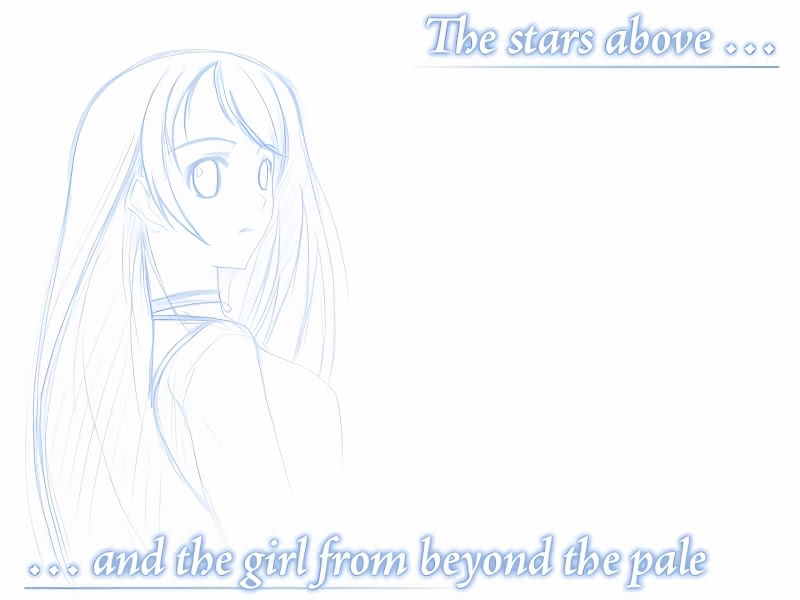
Do note that this article does not spoil the key plot points of Red Shift – but if you have any interest in reading the novel, I would recommend reading it prior to tackling my analysis of the main heroine’s albinism (you may consult my review to see if the novel as a whole interests you).
Background on my interest in hair color issues
I have published numerous articles about hair color in anime and visual novels. My specific interest has been in looking at series and games wherein a character’s hair color receives specific comment, and examining how the world depicted wants us to understand unusual hair colors (should they be taken literally or figuratively?). The series began with my analysis of the hair color of Iroha Isshiki, an important character in the second half of the popular Oregairu series. That post was prompted by the fact that the protagonist (and by effect, the narrator) of the lite novels specifically observed that Iroha had naturally brown hair despite being Japanese, after he had described other characters with non-black hair as having dyed their hair (the post followed my article about real-world natural brown hair issues in Japan). I followed that up with another look into hair color in the Oregairu universe and in-depth pieces on hair color in the Kimi ni Todoke and My Senpai is Annoying anime series.
My only look at hair color in a visual novel previously was a short piece on MYTH, a very peculiar commercial visual novel (available on Steam) which made a point of noting that a character depicted as having pink hair actually had pink hair. Red Shift is a decidedly more indie effort than MYTH despite having been created with the same scripting engine. It was a one-man show, whereas MYTH had a team behind it.
Mikoto’s white hair in Red Shift
Before continuing to analyze Red Shift, I note that my reading of Red Shift is based solely on the official English-language translation. While the English version reads very well, and I have no reason to doubt its accuracy in all meaningful respects, we must remember that Red Shift was originally published in Japanese as Tokoyo no Hoshizora. That is, when I am examining in a granular way when the protagonist, Kouya, first references one point or another about Mikoto’s appearance or specific points therein when the term albino makes an appearance, my analysis is based solely on the translation and not the original. None of these differences ultimately change the fact that Mikoto is albino or that Kouya slowly puts the evidence in front of him together to correctly conclude that Mikoto is albino.
With my disclaimer out of the way, let us establish the nature of the world of Red Shift before we meet the white-haired heroine who plays a starring role in the instant inquiry.
The real-world Japan setting of Red Shift
To begin – for reasons I went through in my earlier hair color articles, it is important to have an understanding of the world in which a Japanese media piece is set before trying to interpret the hair color of the characters. For example, if the setting is fantasy or some other sort of fantastic world, the idea that characters with candy-colored hair should be understood as actually having candy-colored hair is colorable (pun intended). However, if a series has a real-world setting, Toradora! is my go-to example here, we should exercise caution before proclaiming that the straight-A, well-behaved student, actually has blue-green hair. Red Shift, by all accounts, depicts modern-day Japan in the early 2000s. While it has subdued fantastic elements, its setting is very much real-world. This should inform the reader’s initial understanding of Mikoto’s hair color.
The first encounter with Mikoto
But that is enough introduction. Let us meet Mikoto.
(Before continuing, I will note that a couple of the images I chose may be slightly out of order in terms of their appearance, but I chose them carefully to develop how we come to learn about Mikoto’s physical characteristics.)
The protagonist, Kouya, first meets Mikoto while he is sitting on a park bench in the evening.
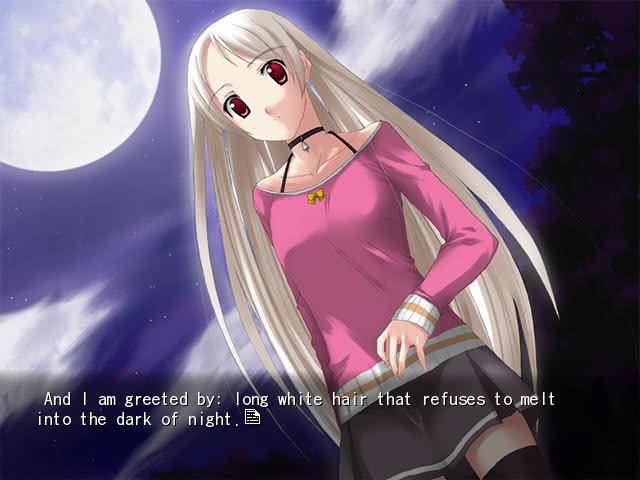
I am greeted by: long white hair that refuses to melt into the dark of night.
This is an important start to understanding Mikoto’s appearance. Although Mikoto appears about 15-20 minutes into Red Shift, she is the first character to physically appear on screen (we do not see the narrator, Kouya, before we see Mikoto). Thus, the reader does not have a frame of reference for considering her unusual appearance. We rely on Kouya, the view-point character, to make a point of noting that what we see is what he sees – Mikoto actually has long white hair.
Astute observers may note that there is another aspect of Mikoto’s appearance which betrays that her hair color should be understood literally. I tell those readers to be patient as we work through the script – we will address that aspect of Mikoto soon.
Next, Kouya notes Mikoto’s complexion:

Skin at least equally as white.
Mikoto has white hair, which is made obvious by the fact that it is nearly the same color as the white Moon – just a bit more color in it. Kouya comments that her skin is as white as her hair. Lest there was any doubt about what Red Shift was telling us, the next line makes it quite clear for careful readers:
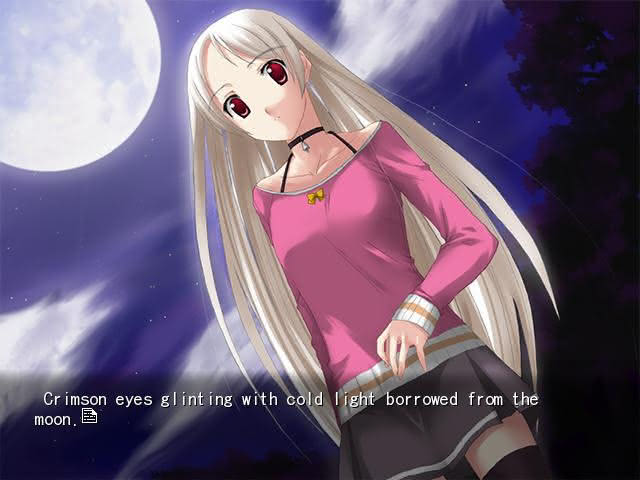
Crimson eyes glinting with cold light borrowed from the [M]oon.
(Before continuing, I credit the translator of Red Shift for some good writing – and the cold light turns out to make sense in the context of the scene. I capitalized “Moon” because referring to our Moon as lower case bothers me – but the translation reads well.)
Given how common unnatural hair colors are in anime, visual novels, manga, and other similar media, it would have been possible to write off Mikoto’s hair, and even her very white skin, as just being the product of artistic choice – especially for a game with a fondness for depicting moonlight. However, in light of her hair color and skin, Mikoto’s red eyes take on a different meaning – and the artist’s attention to detail in making her eyes red cannot be overlooked.
Eyes appearing red is generally associated with albinism. For example, see the following passage from the Mayo Clinic:
The lack of pigment in the colored part of the eyes (irises) makes the irises somewhat translucent. This means that the irises can’t completely block light from entering the eye. Because of this, very light-colored eyes may appear red in some lighting.
Mikoto, thus, most likely does not actually have red eyes, but her albinism affects her eyes, causing them to appear red to Kouya, although I am not sure whether the lighting in that scene would be likely to cause Mikoto’s eyes to appear to be red.
At this point, Kouya had done nothing but describe Mikoto’s appearance. We have a few more lines of description before he moves on to trying to explain her appearance. From the outset, I note that nothing Kouya says upon meeting Mikoto suggests that he finds her attractive per se, but he is clearly struck by her in the glow of the Moon.
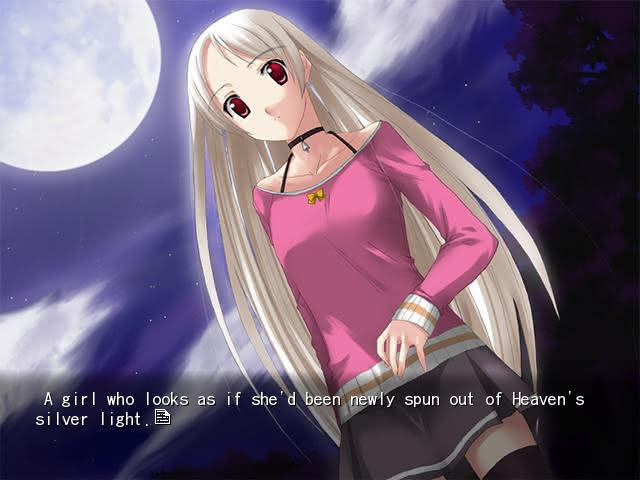
A girl who looks as if she’d been newly spun out of Heaven’s silver light.
He then tied all of his observations together:
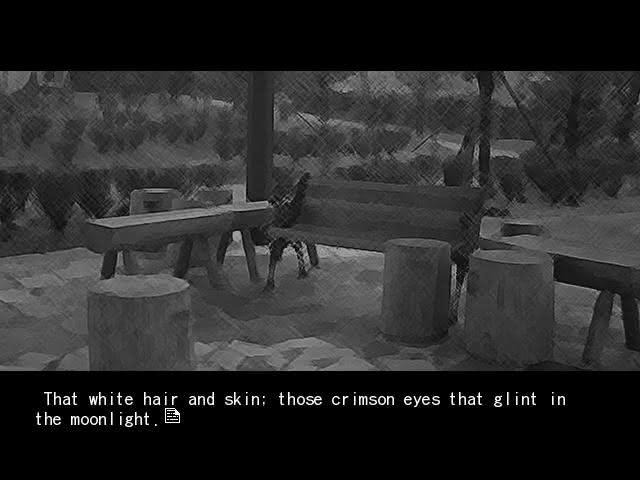
That white hair and skin; those crimson eyes that glint in the moonlight.
At this point, I assumed that Mikoto was literally albino in the game’s world. The red eyes in conjunction with her white hair in the context of a real-world setting were more than enough to lead me to this interpretation. That Kouya carefully described all of the albino aspects of Mikoto’s presentation only made me more confident. Let us summarize the evidence of albinism that the story presented thus far:
- Red Shift has a real-world, modern-Japan setting
- Mikoto is portrayed with three specific albino characteristics
- Kouya makes a point of identifying all of her distinct physical characteristics
There is one potential reason that a reader may resist jumping to declare Mikoto albino at this early stage. In this article, I am using her name – which is revealed not too long after she and Kouya first meet (albeit, toward the end of their interactions). However, Mikoto’s name was not revealed at the time of the foregoing screenshots. Thus, we have one missing element. Kouya has not identified Mikoto as being ethnically Japanese. While there is no reason to doubt that she is Japanese contrast with my notes on non-Japanese characters in Return to Shironagasu Island, there is no confirmation that Mikoto is ethnically Japanese at this stage of Red Shift.
With my one counter-point noted, I assumed with very high confidence at this point that Mikoto was albino. Many (if not most) readers would assume that she was albino. But did Kouya? That was not initially clear, but as I will demonstrate – he did not immediately assume that Mikoto was albino. Instead, he addressed the unanswered question that I described in the previous paragraph:
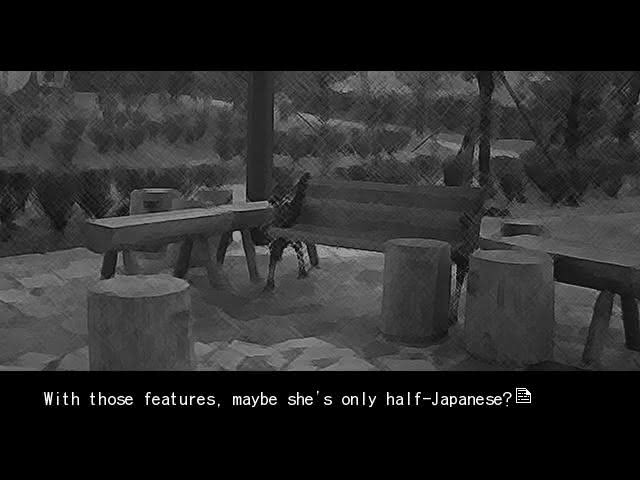
With those features, maybe she’s only half-Japanese?
We learn much in this sentence. Firstly, Kouya’s speculation reveals that he understands this girl whose name he does not yet know as having distinctly Japanese features. If she did not have Japanese features, Kouya would have likely assumed that she was not Japanese at all. Kouya only questions whether she is fully Japanese on account of her white hair and skin and red eyes. That is, she appears to Kouya to be Japanese but for her white hair, white skin, and red eyes.
Lest there was any doubt where Kouya’s mind was at this point, he made it clear:

If that’s the case, one of her parents must be fully Japanese, and the other must have a little foreign blood.
The implicit is now explicit. Kouya is confirming that Mikoto appears to him to be more Japanese than not. There is no indication that the not refers to anything other than Mikoto’s albino features. Kouya is as close to the truth as he imagines that Mikoto is close to being fully ethnically Japanese.
After a small amount of time passed, Kouya reflects further on the strange, still unnamed girl sitting next to him (note that Mikoto had petulantly demanded his seat and he only relented after making his point that her behavior was something less than civil). It appears that he was not fully satisfied with his guess that she was 90% Japanese. He then had a eureka moment:
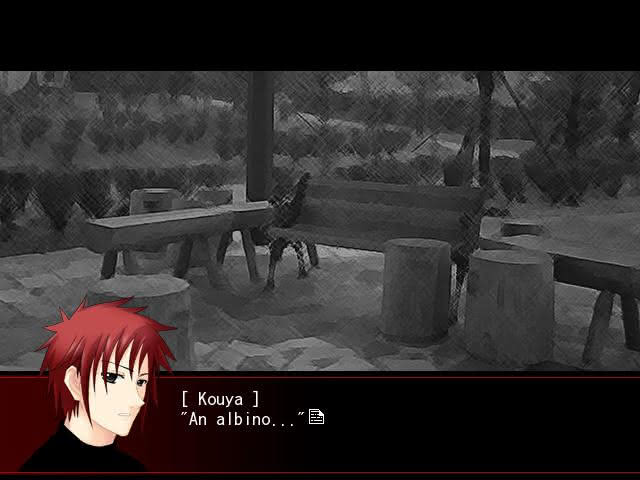
An albino…
Kouya reached the same conclusion as the audience. He went over what he had remembered reading about albinos in his head, and decided that the facts matched Mikoto’s appearance.
(Note: It did not escape my notice that Kouya is depicted above as having reddish hair – which is, suffice it to say, not a hair color ordinarily associated with Japanese people. Moreover, the only other two characters with portraits in Red Shift, with one being Kouya’s older sister, have dark blue and black hair respectively. Red Shift does not address Kouya’s hair at all, but based on the full context of the game – I think that it is more likely than not that he does not literally have red hair. There is no reason to believe that Kouya dyes his hair from anything he says in the game. The choice of red hair for Kouya may have been inspired by his name and by one of the central themes of a game called Red Shift.)
After his eureka moment, he confirmed to himself that he was relatively sure of his guess:

Anyway, she’s probably an albino. All right, that’s the end of that. Stargazing time again.
This is an amusing line in context. As I noted above, Mikoto made a very poor first impression on Kouya. That they were now sitting next to each other on a park bench was not Kouya’s preference. He was trying to relax – but bothered by the idea that he had the answer for Mikoto’s appearance but lacked the word. After he stumbled upon albino in his head, checked his assumption, and decided that his assumption was probably right, he was satisfied enough to stop fretting about it and resume staring at the stars.
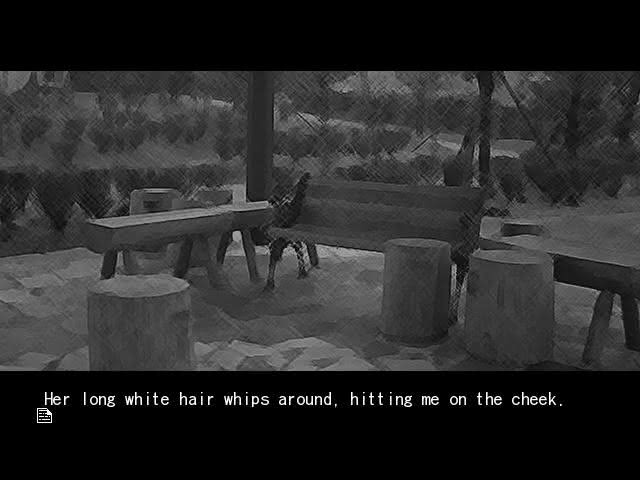
Kouya’s wish for peaceful star-gazing would be unfulfilled. Mikoto re-engaged him in conversation. While she was no longer hostile, the conversation was a bit strained – and this was not ameliorated by Kouya’s discovery that Mikoto was prone to amusing reactions upon being teased. One such reaction caused Kouya to mentally note Mikoto’s appearance again.
After Kouya initially refused to give Mikoto his name (because she did not offer her name first) and then gave her a blatantly obvious pseudonym after she did give him her name, he confessed that he had done so because teasing her and watching her reactions was “so much fun.” Kouya then described to himself the results of said teasing:
Her skin’s so white to begin with that any blush at all is amplified many times over, but still.
Was Kouya sure by this point that Mikoto was albino?
Mikoto alludes to albinism
He was probably sure. But we discover that the issue was still nagging it him the next evening when he was about to walk by the park (Mikoto had told him that she would be in the park again). Kouya, to himself:
Hmm, so maybe Mikoto’s an albino after all.
Is he sure yet? At this point he does seem confident in his guess.
We have another question. Kouya has decided that Mikoto is probably albino. His guess makes sense in light of the extensive evidence that Mikoto is albino. Does Mikoto ever acknowledge that she is albino. She does, although the first acknowledgment is indirect.
When Kouya and Mikoto first meet after their tumultuous initial encounter, Mikoto had to persuade Kouya to spend time with her in the park. Kouya was at first inclined to go home instead.
(Before continuing, I reiterate that my descriptions of their conversations going forward will be written in a manner as to not spoil any of the game’s major plot points or, more aptly put, reveals. Thus, if you find something that one character or another says to be odd, I neither confirm nor deny that everything the character says is exactly as it seems on its face. However, I will spoil, as I have already done, that Mikoto is actually albino.)
After Mikoto persuades Kouya to remain in the park and chat with her, she reveals that her parents keep her from going outside in the daytime – due to her weak constitution (which Kouya has trouble believing based on his initial impressions) and, while not expressly stated in the first instance, another obvious reason is that Sun exposure may not be good for her sensitive skin and eyes. Kouya, while still trying to figure out how he was part of this conversation at all, engaged Mikoto – who had not at this point said that she was albino.
Mikoto stated that here were circumstances in which she was able to go outside:
If I take appropriate measures, then it’s okay for me to walk out in daylight.
Kouya asked if she meant “a parasol and stuff.”
Mikoto replied:
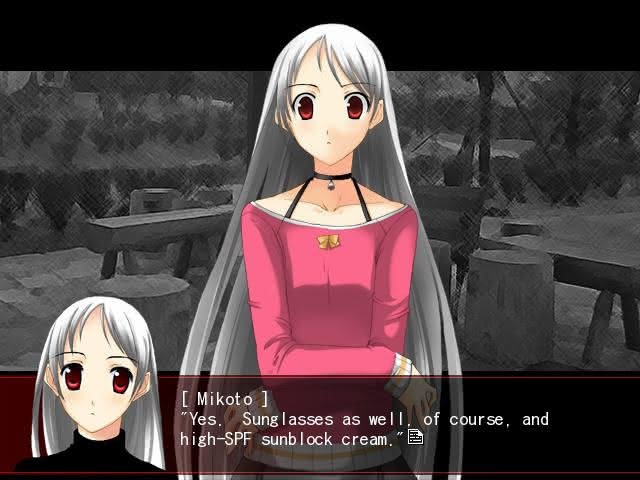
Yes. Sunglasses as well, of course, and high-SPF sunblock cream.
While Kouya still could not believe that Mikoto was unhealthy given the amount of energy she had to yell at him and respond in colorful ways to his occasional provocations, he found himself believing her account and having sympathy for her – I note that their conversation was prompted by her admitting that she did not have friends. To himself he acknowledged that he understood what Mikoto was saying as relating to albinism:
I’ve read that when you’re an albino, you end up having a pretty weak constitution as well.
Careful readers may note an interesting point here. Kouya is on record as suspecting that Mikoto is albino. Mikoto described living under strict restrictions from her parents due to their concerns about her health – all of which are strongly implied to relate to albinism. Yet nowhere in the conversation does the term actually come up. The implicit is still implicit – albeit a loud sort of implicit mimicking Mikoto’s reactions to being provoked by Kouya.
Mikoto’s directly acknowledges albinism
After that conversation on the second day, Mikoto’s appearance, and the consequences of said appearance, fade into the background. This is not an oversight, but is instead owed to the fact that over the course of a few days, Kouya and Mikoto gradually get to know each other and their conversations shift to other topics. Kouya begins thinking less about Mikoto’s striking appearance and more about their conversations and how he can cause her to have amusing reactions.
It is not until well into the visual novel’s second half (note that the story takes about 3 hours to read) that the term “albino” makes another appearance:
Four days ago, I met a young albino girl in the park.
For this final reference, I will be very limited in what I can say because the scene in question occurs in the decisive stages of Red Shift, ensconced among what would constitute significant spoilers for those who have not already read the story. Because my review encouraged people to read Red Shift, I will refrain from spoiling the story in a post about hair color. It should suffice to say that there is more to Mikoto than meets the eye (this is a point most readers will likely suspect in context around the same time they pick up on her albinism). Kouya, in referencing that, wondered if his assumptions about her albinism and the effects thereof was true:
[W]hat about being an albino?
It was only at this point, very late in Red Shift, that Mikoto herself directly addressed the matter:
That much is true.
Mikoto appeared to be albino. She described having problems that would be associated with albinism. In the end, she acknowledged that she was, in fact, albino.
Is albinism common in Japanese visual novels?
While I am in the midst of a long Japanese visual novel review project here at The New Leaf Journal, with Red Shift being part of that project, I have watched a great deal more anime than I have played visual novels. On the anime front, I cannot say that I can think of a character who was expressly albino off the top of my head, despite having seen a few hundred anime series and movies over the last 15 years. I may be forgetting a character or a story-line, but none jump to mind while writing this. Note that I am distinguishing albinism from merely having white hair. White or silver hair is not uncommon ( a couple of teenage characters in Oregairu are depicted as having white hair). I refer not to merely having white hair, but having white hair on account of being albino.
My experience with anime suggests that actual albinism would not be common in visual novels. Sure enough, I do not recall having encountered any overtly albino characters other than Red Shift’s Mikoto Kujou. But there are many visual novels that I have not read.
Red Shift has a tag for “albino heroine” on the Visual Novel Database, an amazing free and open source visual novel collection (see Red Shift’s VNDB entry). As of November 14, 2022, the albino heroine tag returned 153 results, with one being Red Shift. 153 albino heroines would not be too many in light of the fact that there are, as of November 14, 2022, 38,073 visual novels in the index, although Visual Novel Database includes visual novels from all around the world, not just Japan. But do we even have 153 genuinely albino heroines? The Visual Novel Database defines what the tag means:
A heroine’s appearance in this game resembles to an albino; she has white hair, and her eyes have unnatural color (like red or almost transparent blue).
The tag only refers to female characters who have certain characteristics associated with albinism. It is not restricted only to characters who are actually albino. This is what I suspected when I initially saw the tag before checking its description.
To the best of my knowledge and recollection, I have not read any of the visual novels among the 153 other than Red Shift. However, if I come across any other albino characters in visual novels, I will append a short update to the instant article.
Conclusion
Red Shift’s handling of Mikoto’s albinism was one of the more interesting hair color stories that I have looked at in anime, manga, games, lite novels, and other media of the like – perhaps rivaled only by Oregairu’s curious choice to point out that Iroha Isshiki had naturally brown hair. The author handled Mikoto’s albinism in a detailed way for the medium, from her character design to Kouya’s internally looking for the term to describe her appearance. Perhaps the author understood that because the visual novel medium contains many works with fantastical hair colors he needed to make the point of Mikoto’s albinism clear for readers to understand that her appearance was to be understood literally.
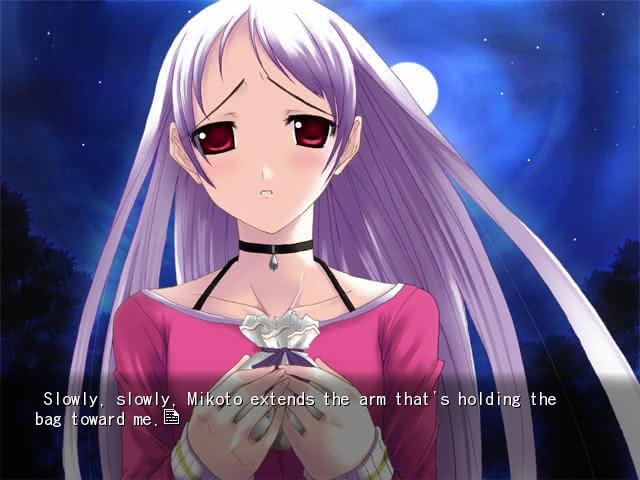
While Mikoto does not explicitly acknowledge being albino until the end of the game, she and Kouya dispensed with the issue relatively early in their second meeting, during which Mikoto described some of the challenges that came with being easily sunburned. After that conversation, Mikoto’s albinism faded into the background as her and Kouya’s conversations shifted to other topics.
Mikoto’s albinism ultimately plays a relatively small, but not insignificant, role in Red Shift. It is not a mere afterthought but, without going into too much detail, the story did not depend on Mikoto being albino. For example, she could have had other sorts of health issues to explain her behavior. I venture that the author had a four main reasons for making Mikoto albino:
- Her albinism gave her a backstory which explained why she was eager to spend time with Kouya and why she went to the park in the evening
- Her appearance is attention-grabbing, which is important for a visual novel with very simple art and a small number of characters
- Mikoto’s (apparently) red eyes, which are characteristic of albinism work aesthetically with some aspects of Red Shift
- Mikoto’s appearance works well with the author’s interest in depicting moonlight
I credit Red Shift for taking Mikoto’s character in an unusual direction and doing so in a well thought-out way, offering ample material for one of the Internet’s leaders in anime and visual novel hair color commentary to turn into a new article.